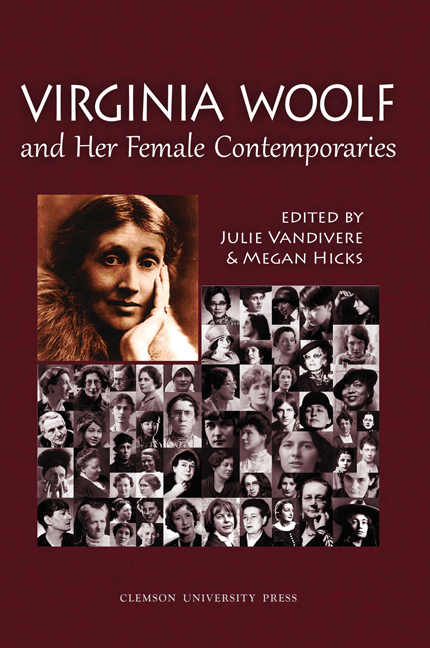Book contents
- Frontmatter
- Table of Contents
- Introduction
- Acknowledgments
- Abbreviations
- Who Are Virginia Woolf's Female Contemporaries?
- Considering Contemporaneity: Woolf and “the Maternal Generation”
- Who Is My Contemporary?: Woolf, Mansfield, and Their Servants
- “The World is My Country”: Emma Goldman among the Avant-Garde
- “Definite, Burly, and Industrious”: Virginia Woolf and Gwen Darwin Raverat
- “A Verbal Life on the Lips of the Living”: Virginia Woolf, Ellen Terry, and the Victorian Contemporary
- Twists of the Lily: Floral Ambivalence in the Work of Virginia Woolf and Georgia O'Keeffe
- Virginia Woolf's Cultural Contexts
- Virginia Woolf's Contemporaries Abroad
- Virginia Woolf's Contemporaries at Home
- Tribute to Jane Marcus
- Notes on Contributors
- Conference Program 223
Considering Contemporaneity: Woolf and “the Maternal Generation”
from Who Are Virginia Woolf's Female Contemporaries?
- Frontmatter
- Table of Contents
- Introduction
- Acknowledgments
- Abbreviations
- Who Are Virginia Woolf's Female Contemporaries?
- Considering Contemporaneity: Woolf and “the Maternal Generation”
- Who Is My Contemporary?: Woolf, Mansfield, and Their Servants
- “The World is My Country”: Emma Goldman among the Avant-Garde
- “Definite, Burly, and Industrious”: Virginia Woolf and Gwen Darwin Raverat
- “A Verbal Life on the Lips of the Living”: Virginia Woolf, Ellen Terry, and the Victorian Contemporary
- Twists of the Lily: Floral Ambivalence in the Work of Virginia Woolf and Georgia O'Keeffe
- Virginia Woolf's Cultural Contexts
- Virginia Woolf's Contemporaries Abroad
- Virginia Woolf's Contemporaries at Home
- Tribute to Jane Marcus
- Notes on Contributors
- Conference Program 223
Summary
Is there any use in contemporaries writing about contemporaries—even if some are older and some younger? I can't see it; but if you can, come and explain it.
—Virginia Woolf to Stephen Spender, December 16, 1939 (L6: 374)We typically use the noun form of the word “contemporary” in two related but slightly different ways. It can mean not only a person who is the same age as you, but also a person who lives at the same time as you. Scanning the list of writers mentioned in the call for papers for the conference, it would seem that both definitions are in play, even if the one based on chronological age arguably predominates. The eldest, Colette and Dorothy Richardson, were born in 1873, followed by Gertrude Stein and Amy Lowell the next year; the youngest, Kay Boyle and Una Marson, were born several years after the turn of the century. The older contemporaries, then, are about ten years senior to Woolf; the younger contemporaries are at least two decades her junior. Only five on the list of 18 names (which is obviously not meant to be exhaustive) were born in the same decade and only one in the same year. To say that all of these writers were of the same chronological age, then, would be something of a stretch; yet most of us would probably consider all of them as belonging to the same generation.
If we foreground the definition that focuses not on age but on temporal simultaneity or “contemporaneity,” however, a different range of possibilities arises. People who live at the same time as you do are also your contemporaries—no matter how differently each of them might experience that time, based on age and a host of other factors. Sometimes, but very rarely, they are your exact contemporaries, like Joyce and Woolf, born just a week apart. But more often they are younger or older, as my epigraph from Woolf 's letter to Spender, who was born in 1909, suggests that she understood. At the time of writing that letter, near the end of her career, Woolf was quite forcefully engaging with her younger contemporaries—as in the essay in which she describes Auden, Day Lewis, Isherwood, MacNiece, and Spender himself, all born in the first decade of the twentieth century, as the “leaning tower” writers.
- Type
- Chapter
- Information
- Virginia Woolf and Her Female Contemporaries , pp. 2 - 7Publisher: Liverpool University PressPrint publication year: 2016



